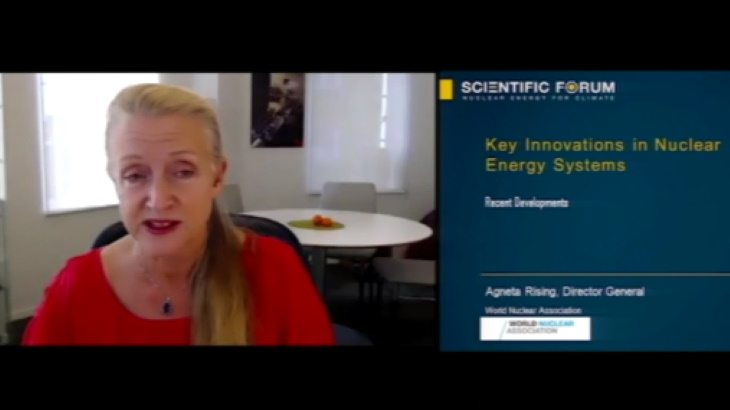Rising said a rapid increase in reliable low-carbon nuclear generation is needed if the world is to meet its climate change targets while also meeting sustainable development ambitions. At the same time, energy demand is expected to grow, with electricity consumption making up a major share of this as we increasingly electrify heating and transport.
Nuclear generating capacity needs to grow six-fold by 2050 and achieve 25% of electricity generation in order to keep the global temperature rise bearable, she said. However, Rising noted that projections from the International Energy Agency and the IAEA indicate that the projected growth of nuclear energy will not be sufficient to meet this increasing demand.
"Innovation can help to overcome many of the challenges that nuclear is currently facing and which is holding back its growth," Rising said. "Fortunately, there are recent signs that the speed of innovation in the nuclear sector is accelerating. This is occurring across the life cycle of a nuclear power plant and across the wider fuel cycle."
She noted that in many key growth countries nuclear reactor projects are being delivered successfully to cost and schedule. An example of this is the recent completion of construction of China's Tianwan unit 5 in less than five years. In addition, while recent first-of-a-kind projects in Western countries have run into difficulties, there are signs that the industry has started to overcome these challenges. "Innovation in design and construction practices are driving down project risks, schedules and costs," Rising said. Examples of this include digitalisation of plant information and serial construction.
Innovation also continues to drive improvement in the performance of existing nuclear power plants. Last year, the Tarrapur plant in India turned 50-years-old, while the Turkey Point plant in the USA was the first to be licensed to operate for 80 years. "This highlights that innovation and flexible goal-based licensing is key for reactors to achieve their potential," Rising said.
"Innovation is also of course key for creating the nuclear plants of tomorrow," she added. "These will not only provide electricity but also a range of other energy applications such as domestic heat, high temperature industrial process heat, hydrogen production, and desalination."
Rising said that small modular reactors (SMRs) used to be considered "future technologies", but there are now demonstration plants in operation or about to begin construction. "As more and more SMR designs mature, their role is expected to grow rapidly in the 2030s and 2040s," she said.
Innovations in the nuclear fuel cycle are also improving the competitiveness and security of fuel supply, as well as the performance of reactors. Enhanced fuels improve the safety of nuclear operations and offer the potential for longer operating cycles, plant uprates and operational cost savings.
"Of course some of the more famous challenges in nuclear revolve around the back-end of the fuel cycle and the end of the plants lifecycle," Rising noted. She said a number of important topics related to decommissioning have been addressed through international cooperation and exchange between various research programmes. "We already have sustainable solutions for nuclear waste."
"For the nuclear sector, innovation in market design, financing, regulation, and project delivery, will be key to reducing costs of new build, unlocking the full potential of existing facilities and facilitating advanced reactors," Rising said.
When asked which innovations she considers the most crucial to boost nuclear's share of the energy mix to combat climate change, Rising said if we are going to do anything soon, we need to continue constructing large reactors as we already have experience in this. "The task is enormous and the timescale not that long. But over time we will see more SMRs coming in." In addition to power generation, these units could also be used for heating and industrial process heat, she noted.






_63865.jpg)
_18570.jpg)
_16159.jpg)





